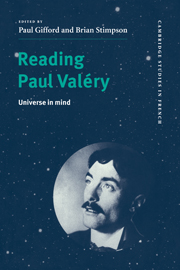Book contents
- Frontmatter
- Contents
- Contributors
- Abbreviations
- Introduction
- PART 1 SELF-SCIENCE
- PART 2 SELF-WRITINGS
- 6 The poetics of practice and theory
- 7 ‘Esprit, Attente pure, éternel suspens …’: Valéry's prose poetry
- 8 Counter-fiction
- 9 The Dialogues and Mon Faust: the inner politics of thought
- 10 Major poems: the voice of the subject
- 11 Other voices: intertextuality and the art of pure poetry
- 12 Manuscript steps: ‘Les Pas’
- PART 3 BODY, MIND, WORLD
- Conclusion
- Bibliography
- Index
- Cambridge Cultural Social Studies
9 - The Dialogues and Mon Faust: the inner politics of thought
Published online by Cambridge University Press: 04 August 2010
- Frontmatter
- Contents
- Contributors
- Abbreviations
- Introduction
- PART 1 SELF-SCIENCE
- PART 2 SELF-WRITINGS
- 6 The poetics of practice and theory
- 7 ‘Esprit, Attente pure, éternel suspens …’: Valéry's prose poetry
- 8 Counter-fiction
- 9 The Dialogues and Mon Faust: the inner politics of thought
- 10 Major poems: the voice of the subject
- 11 Other voices: intertextuality and the art of pure poetry
- 12 Manuscript steps: ‘Les Pas’
- PART 3 BODY, MIND, WORLD
- Conclusion
- Bibliography
- Index
- Cambridge Cultural Social Studies
Summary
Consideration of the place of the Dialogues in relation to the rest of Valéry's work is at once a literary and an historical issue; which is not to confine it, merely, to literary history. Evidence for the importance of the genre is certainly compelling: from 1921 onwards the dialogue form is the major public genre adopted by Valéry, apart, that is, from the essay. The Dialogues form an extensive corpus: Eupalinos ou l'architecte and L'Ame et la danse were published in 1921 and were followed by L'Idée fixe ou deux hommes à la mer (1932) and Dialogue de l'arbre (1943); to these must be added the Colloques ‘Socrate et son médecin’ (1936), ‘Orgueil pour orgueil’ (1939) and ‘Colloque dans un être’ (1939), collectively re-published in Mélange (1939); the libretti for the two operatic melodramas Amphion (1931) and Sémiramis (1934); and finally the dramatic sketches for ‘Mon Faust’ (1941). In addition there were many unpublished or unfinished texts such as the ‘Dialogue des choses divines’ (‘Peri tôn toû theoû’) begun in 1921 and pursued throughout the rest of the Cahiers.
This list is all the more remarkable when one considers that there was little explicit use of the dialogue form prior to 1921; from this perspective, it would appear that Valéry the poet gives way to the writer of dialogues. But this over-simple division requires more complex shading: for there is a sense in which the intimate dialogue with self is at the very heart of the Valéryan project, whatever the expressive modality.
- Type
- Chapter
- Information
- Reading Paul ValéryUniverse in Mind, pp. 155 - 169Publisher: Cambridge University PressPrint publication year: 1999

